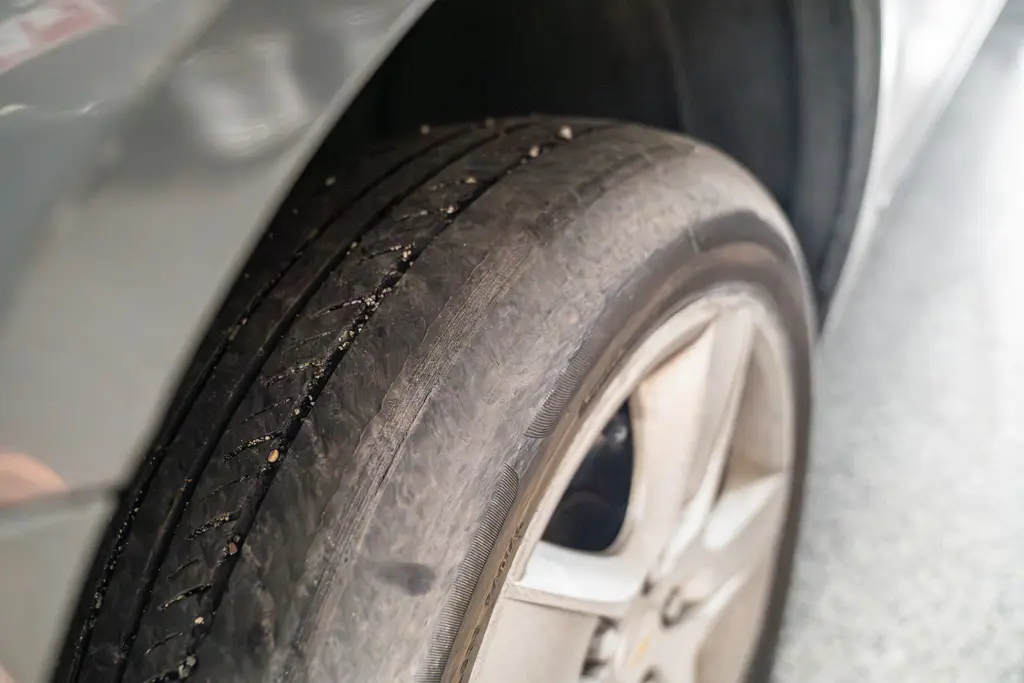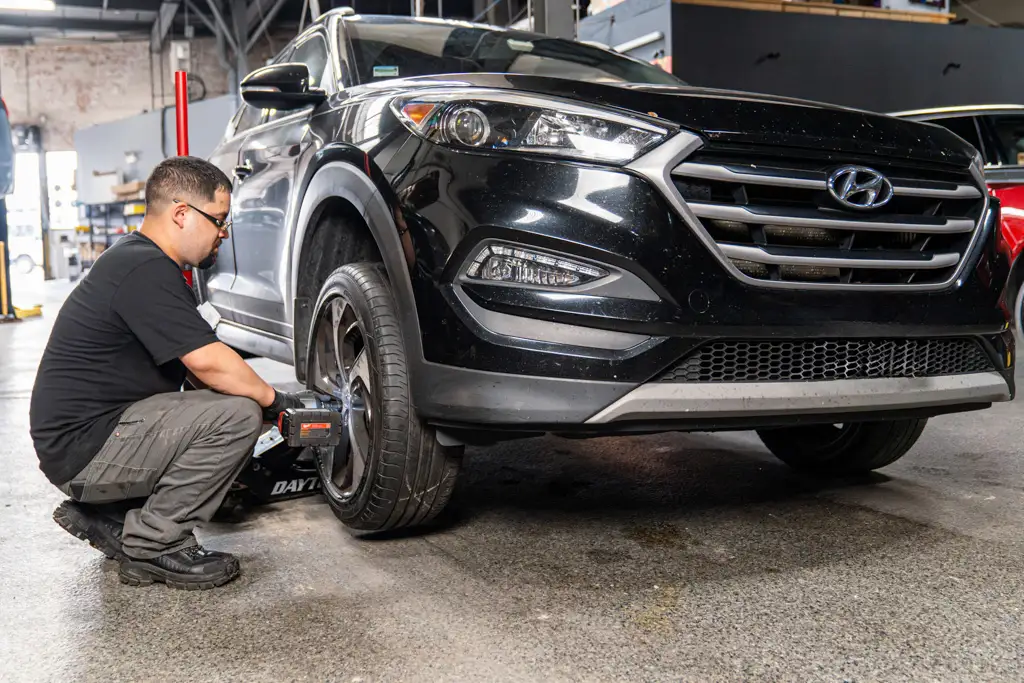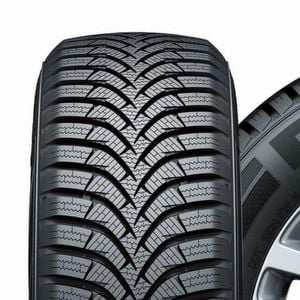Last Updated on 14.08.2024 by hrushetskyy

The answer to the question “Do my tires need to be rotated?” is a definite “Yes.” Our expert explains why and tells how often to rotate tires to stay safe.
Do My Tires Need to be Rotated? UTires Expert Explains How Often
Tires need to be regularly rotated to last longer and wear evenly. However, many drivers overlook this essential maintenance step, endangering themselves, their passengers, and all other traffic participants. We hope that after reading this Guide, you will understand the importance of tire rotation in road safety and never skip it again.
Why do I need tire rotation? Shocking statistics

According to the National Highway Traffic Safety Administration (NHTSA) statistics, 562 people died in 2022 due to tire-related crashes. The NHTSA’s Vehicle Safety Awareness page states, “Poor tire maintenance—not having enough air in your tires and failing to rotate your tires, among other maintenance requirements—can lead to a flat tire, blowout, or the tread coming off your tire.”
Rotation is the process of swapping a car’s tire positions to extend their lifespan and improve performance. Put simply, you need to rotate your tires to prevent uneven wear, which can lead to the above-mentioned consequences.
Every tire wears at a different rate, as the weight distribution varies from left to right, from front to rear. The front wheels carry more load due to the engine and transmission located in front. Plus, they take the most stress during turns and braking. For front-drive vehicles, the pressure on the front tires will be amplified. Due to right-hand driving and the direction in most parking ramps in the U.S., the front left tire experiences more impact and wears more.
Tires also need to be rotated to improve your vehicle’s gas mileage. More tread means less contact patch area, which, in turn, means less friction. The result is lower rolling resistance, which is a key to fuel economy.
Including tire rotation in your regular maintenance routine will make your tires last longer and save lives. Think about it.
Signs your tires need rotation

It’s super important to recognize the signs that your tires need rotation. Uneven wear between tires, vibrations, and the vehicle pulling to one side are all clear indicators of a necessary tire rotation. If you can’t remember the last time you had your tires rotated, there’s a good chance they’re overdue.
Uneven wear between tires
In this case, we use the term “uneven wear” not to indicate an irregular pattern throughout the tread of one tire but to indicate that the front tires wear faster than the rear ones. If that’s your case, get them rotated ASAP.
However, you may also notice an irregular wear pattern on one of your front tires, with one side having less tread than the other. If the treadwear isn’t severe, the tire can still be rotated, but replace it if it’s lower than 4/32”. If you think your tires are unsafe for driving, check out our Tire Buying Guide and see if it’s time you get a new set.
Vehicle vibration
Vehicle vibration felt at a speed of 45 mph or higher may be caused by uneven tire wear. However, uneven wear isn’t the only cause of vehicle vibration; the most frequent is tire imbalance. Nevertheless, be aware that when you notice an unusual vibration while driving, your tires must either be rotated or balanced or your wheels aligned.
Vehicle pulling to one side
If your vehicle pulls to one side while you driving, it could be a sign that your tires, including the rear left tire, need rotation. This pulling is often caused by uneven tire wear or misalignment. Regular tire rotations can help distribute wear evenly across all tires, reducing the chances of your vehicle pulling to one side.
How much does tire rotation cost?
The cost of tire rotation can vary depending on several factors, including the type of vehicle and the tire shop you choose. On average, you can expect to pay between $20 and $60 for a standard tire rotation, but the price can reach up to $120 for exclusive car models or at dealerships. Some tire shops may offer free rotations if you purchase tires from them. Plus, many tire services offer warranties of about six months, giving you peace of mind about the condition of your rubber.
How often to rotate tires
Tires should generally be rotated every 5,000 to 8,000 miles to maintain their top shape and ensure even wear.
For front-wheel drive (FWD) and rear-wheel drive (RWD) vehicles, rotations should occur every 5,000 to 7,500 miles.
All-wheel drive (AWD) vehicles may require more frequent rotations, typically every 3,000 to 5,000 miles.
A little tip: combine tire rotations with regular service intervals, such as oil changes. It’s easier to remember this way.
Benefits of regular tire rotations

Extended tire lifespan
Rotating your tires helps each tire wear out evenly, counteracting the uneven wear that occurs due to the front of your car being heavier than the rear. This will extend tires’ lifespan, prevent premature replacements, and reduce long-term costs. Regular tire rotations also alleviate stress on the drivetrain, which is particularly important for all-wheel-drive vehicles.
But regular tire rotations go far beyond extending the lifespan of your tires, resulting it:
- Better grip and responsiveness, especially in adverse weather conditions
- Consistent tread depths, maintaining optimal traction and handling
- Enhanced safety on the road
Improved fuel efficiency
Evenly worn tires reduce rolling resistance and help maintain optimal fuel efficiency. Conversely, unbalanced tires can cause uneven tread wear and decrease fuel efficiency. Regular tire rotations can improve your vehicle’s fuel economy by up to 3%.
Enhanced safety
Tire rotation helps maintain uniform tread depth, which supports consistent traction and handling. Uneven tire wear can lead to heat buildup, which compromises tire performance and safety. Properly rotated tires give better car control and reduce the risk of accidents, which is especially important in adverse weather conditions.
Tire rotation pattern: which one to choose?
Understanding common tire rotation patterns can help you maintain even wear and extend the life of your tires. According to the Tire and Rim Association, drivers should use the following patterns.
For non-directional tires of the same size and offset
Forward cross
The front tires move back on the same sides, while the rears go to the opposite sides to the front. Use this pattern if you have a front-drive vehicle.
X-pattern
The fronts move to the opposite sides on the rear axle, while the rears move to the opposite sides on the front axle. This pattern is also for front-drive vehicles.
Rearward cross
Here, the front tires go to the opposite sides of the rear, while the rear tires move straight to the front positions. This pattern is for 4-wheel and rear-wheel-drive vehicles.
For directional high-performance staggered/non-staggered tires
Front-to-back
For directional tires of the same size, exchange the places on the front and rear tires of the same side.
Side-to-side
For non-directional tires of different sizes, rotation has to be side-to-side, so the rears remain on the rear axles and the front tires—on the front.
NOTE: If you have directional tires of a different size, you should dismount them and remount them on the opposite side.
For vehicles with a full-sized and fully functional non-directional spare
Forward-cross
The rear tires go to the opposite places at the front, while the left front tire goes to the rear left side, and the spare tire goes to the rear right side. The right front tire becomes a spare. This pattern is for front-wheel-drive vehicles.
For 4-wheel or rear-wheel drive: rearward cross
This pattern has the left rear tire on the left front and the right front tire on the left rear. The spare goes to the right rear place, and the right rear takes the right front position. As a result, the left front tire remains as a spare. This pattern works for 4-wheel and rear-wheel drive cars.
NOTE: For a 6-wheel tire rotation, check the Rubber Manufacturers Association Tire Care & Safety guide. It will provide you with a comprehensive outlook on keeping your tires out of trouble.
The importance of professional tire rotations
We recommend professionally rotating your tires because we want you to be safe on the road. A technician will inspect your tires for potential damage, check air pressure, and rebalance them in case of issues (vibrations, uneven wear, pulling to one side). DIY methods simply may not cover all these concerns. But if you’re sure of your capabilities, you may as well rotate tires yourself. DIY rotation can save you money on labor costs and provide a learning experience, but it requires proper tools and knowledge. Here are 9 essential steps to perform while rotating tires on your own:
Rotating tires on my own: 9 steps

- Park the car and set the parking brake.
- Block the tires opposite the side you will be working on first. This will prevent the car from moving while you’re rotating the tires.
- Loosen the lug nuts so it’s easier to spin them off when the car is elevated.
- Use a car jack and get jack stands for every wheel if you find it necessary. This is recommended, especially if you have a jack that came with your vehicle.
- Remove lug nuts with a lug wrench and put them somewhere safe.
- Remove the front and rear wheels and swap their positions.
- Before remounting the wheels to their new places, inspect the tires and look for uneven wear, punctures, cuts, or any other damage. Also, check whether the tread has reached its treadwear bars; if it has, the depth is 2/32” or lower. If it is, this means you need a new tire as soon as possible.
- If everything is alright, mount the wheels and tighten the lug nuts. Then, use a torque wrench to tighten them further, according to the manufacturer’s specifications. If you don’t find the recommendations in your owner’s manual, you can always refer to wheel-size.com for the needed information. Try placing the lug nuts diagonally from one another to achieve better results.
- Go to the other side and repeat the above steps.
NOTE: This algorithm is good for the easiest front-to-rear rotation. If your tires need to be rotated in a more complicated pattern, you may need another sequence of actions and further help.
Spare tire rotation: yes or no?

When your tires need to be rotated, including the spare in the pattern is a good idea. However, this only refers to spares with the same size, load rating, and type of tire as your road tires. For vehicles with a “full-size” spare, the following rotation patterns may be used:
If your spare has a “T” in its sidewall code, it means it is for temporary use only and should be used only to get to the nearest tire shop to repair or change the damaged main tire. A temporary tire is usually much smaller than the main-set tires and looks like a donut.
NOTE: Once you’ve rotated your spare tire (if it’s the same type as your regular one), you get an additional 20,000 miles in the trunk.
The importance of tire rotation
Regular tire rotations are an essential part of regular tire maintenance. They extend the lifespan of your tires, help the tread to wear evenly, and play an important role in optimal vehicle performance. Don’t overlook the importance of this simple routine! It keeps you safe on the road and makes your overall driving experience more pleasant.
Frequently Asked Questions
How often should I rotate my tires?
You should rotate your tires approximately every 5,000 to 8,000 miles to ensure even wear and optimal performance.
Why do the tires on the drive axle wear faster?
The tires on the drive axle wear faster due to the transmission, power, and torque applied to them, causing greater friction and stress on the tires.
Should I include my spare tire in the rotation?
Yes, include your spare tire in the rotation process if it has the same size, load rating, and type as your main tires. This helps ensure even wear and prolongs the life of all your tires.
Do radial tires need to be rotated?
Yes, tires of any construction (radial, bias-ply, or bias-belt) need to be rotated. Nowadays, most of the tires on the market are radial, so all the rules apply to them in the first place.
What is the difference between tire rotation and balancing?
Tire rotation involves position changes on the vehicle’s axles. It’s done to achieve even weight distribution between the tires, unlike tire balancing, which doesn’t require a tire position change but deals with weight distribution within the tire itself. This article explains tire balance and what to do if you need it. Remember that both processes are equally important for even treadwear, tire lifespan, absence of vibrations, and vehicle safety.
Do tires need balancing after rotation?
No, if your rotation pattern doesn’t involve dismounting a tire off its rim. When the tire-wheel unit is balanced, it doesn’t matter what side of the vehicle it is on. However, checking whether the tires are properly balanced every time you rotate them would be wise. Balance can break when the vehicle hits a large pothole at high speeds or the tire wears out enough for the weight distribution to change.
Do trailer tires need to be rotated?
Yes, but you shouldn’t rotate them along with the vehicle tires unless they have the same specifications. Two- and three-axle trailers usually require more attention to tire rotation, but it’s a good idea to check your one-axle trailer once in a while, too. You can rotate the tires using the X pattern (rear-right to front-left, rear-left to front-right, middle (if any) side-to-side). Another easier pattern is to rotate the tires on the same axle side to side. Note that trailer tires are usually marked with “ST” before the size code.
After the tires are rotated, are they aligned?
Wheels are aligned independently from tire rotations, as the procedure’s main element is suspension. Whatever wheel you put on it will be aligned if it’s aligned right. However, it would be a good idea you check the alignment every time you rotate the tires. This will ensure the alignment is right, and your tires will wear evenly, as well as the suspension.
How often do truck tires need to be rotated?
As often as any other tires or as often as specified in the owner’s manual. The rule of thumb is to rotate the tires every 5,000-8,000 miles, but some manufacturers recommend rotation every 3,000 miles.
How to tell my tires were actually rotated?
The best way is to mark your tires beforehand to know which is which. Also, if you keep an eye on your tires, you should know whether there’s any uneven wear on any of them. This will also help you determine whether your technician has rotated the tires. Besides, if you have directional tires, check whether they are in the right place. An inexperienced technician may have rotated the tires and put them in the wrong places.

